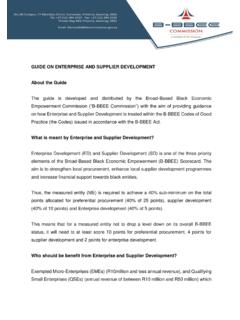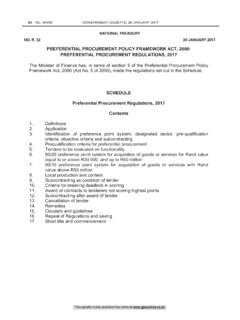Transcription of IMPLEMENTATION GUIDE PREFERENTIAL PROCUREMENT …
1 IMPLEMENTATION GUIDE PREFERENTIAL PROCUREMENT REGULATIONS, 2017 PERTAINING TO THE PREFERENTIAL PROCUREMENT POLICY FRAMEWORK ACT, ACT NO 5 OF 2000 March 2017 IMPLEMENTATION GUIDE : PREFERENTIAL PROCUREMENT REGULATIONS 2017 Page 2 of 24 TABLE OF CONTENTS GENERAL 1. ACRONYMS AND ABBREVIATIONS 2. PURPOSE 3. APPLICABILITY 4. INVITATION TO TENDER / REQUESTS FOR QUOTATION 5. APPLICATION OF PRE-QUALIFICATION CRITERIA 6. TENDERS BASED ON FUNCTIONALITY AS A CRITERION 7. APPLICATION OF PREFERENCE POINT SYSTEMS 8. IDENTIFICATION OF APPLICABLE PREFERENCE POINT SYSTEM 9. BROAD-BASED BLACK ECONOMIC EMPOWERMENT (B- bbee ) STATUS LEVEL CERTIFICATES 10.
2 VALIDITY OF B- bbee STATUS LEVEL VERIFICATION CERTIFICATES 11. VERIFICATION OF B- bbee LEVELS IN RESPECT OF EMES 12. ELIGIBILITY AS qualifying small ENTERPRISES (QSE) 13. LOCAL PRODUCTION AND CONTENT 14. SUB-CONTRACTING AS A CONDITION OF TENDER FOR PROCUREMENT ABOVE R 30 MILLION 15. EVALUATION OF TENDERS BASED ON FUNCTIONALITY AS A CRITERION 16. EVALUATION OF TENDERS BASED ON A STIPULATED MINIMUM THRESHOLD FOR LOCAL PRODUCTION AND CONTENT 17. EVALUATION IN TERMS OF PRICE AND PREFERENCE POINT SYSTEMS 18. CRITERIA FOR BREAKING DEADLOCK IN SCORING 19. NEGOTIATING A FAIR MARKET RELATED PRICE 20. CANCELLATION OF TENDERS 21. AWARD OF CONTRACTS TO TENDERER NOT SCORING THE HIGHEST TOTAL POINTS 22.
3 REMEDIES 23. TAX CLEARANCE IMPLEMENTATION GUIDE : PREFERENTIAL PROCUREMENT REGULATIONS 2017 Page 3 of 24 24. BIDDING DOCUMENTS 25. TRANSITIONAL ARRANGEMENTS IMPLEMENTATION GUIDE : PREFERENTIAL PROCUREMENT REGULATIONS 2017 Page 4 of 24 GENERAL 1. ACRONYMS AND ABBREVIATIONS AO /AA Accounting Officer / Accounting Authority B-BBEEA Broad Based Black Economic Empowerment Act, Act No 53 of 2003 as amended. BVA BEE Verification Agency CIPC Companies and Intellectual Property Commission EMEs Exempted Micro Enterprises IRBA Independent Regulatory Board of Auditors MFMA Municipal Finance Management Act, Act No 56 of 2003 PFMA Public Finance Management Act, Act No.
4 1 of 1999 (as amended by Act 29 of 1999) PPPFA PREFERENTIAL PROCUREMENT Policy Framework Act, No 5 of 2000 QSE qualifying small Enterprise SANAS South African National Accreditation System SARB South African Reserve Bank SARS South African Revenue Services SCM Supply Chain Management *For the purposes of this IMPLEMENTATION GUIDE the term bid has the same meaning assigned to the term tender . Furthermore, the term tender / bid also includes price quotations, unless specifically excluded. IMPLEMENTATION GUIDE : PREFERENTIAL PROCUREMENT REGULATIONS 2017 Page 5 of 24 2. PURPOSE This GUIDE is intended to assist Accounting Officers and Accounting Authorities with the IMPLEMENTATION of the PREFERENTIAL PROCUREMENT Regulations, 2017 issued in terms of section 5 of the PREFERENTIAL PROCUREMENT Policy Framework Act, Act Number 5 of 2000 (PPPFA).
5 The GUIDE should be read and utilized in conjunction with other relevant SCM related prescripts, instructions, circulars and guidelines. 3. APPLICABILITY Institutions The PREFERENTIAL PROCUREMENT Regulations, 2017 are applicable to organs of state as contemplated in section 1 (iii) of the PPPFA and all public entities listed in Schedules 2, 3A, 3B, 3C and 3D to the PFMA, municipalities and municipal entities. These organs of state and entities referred to in above are hereafter referred to as institutions in this GUIDE . 4. INVITATION TO TENDER/ REQUESTS FOR QUOTATION PLANNING, STIPULATION OF PREFERENCE POINT SYSTEM TO BE UTILISED AND THE DETERMINATION OF DESIGNATED SECTORS Prior to the invitation of tenders, AOs/AAs are required to: Properly plan for the provision of goods and services, to ensure that the PROCUREMENT plan is aligned to the needs identified in the strategic plan of the institution and that goods and services are delivered at the right time, right price, right place and that the quantity and quality will satisfy those needs.
6 As far as possible, accurately estimate the costs for the provision of the required goods or services. This is in order to determine and stipulate the appropriate preference point system to be utilized in the evaluation and adjudication of the tenders and to also ensure that the prices paid for the services, works and goods are market related. Estimated costs can be determined by conducting an industry and commodity analysis to obtain indicative market related prices that may be utilized for benchmarking purposes. Based on the findings, the relevant preference point system (80/20 or 90/10) to be utilized for the evaluation of the tender must be stipulated in the tender documents; Determine whether the sector, sub-sector, industry or products for which an invitation is to be made have been designated for local production and content in terms of Regulation 8 of the PREFERENTIAL PROCUREMENT Regulations.
7 If designated, institutions must include a specific condition in the tender documents that only locally produced goods or locally manufactured goods with a stipulated minimum threshold for local production and content will be IMPLEMENTATION GUIDE : PREFERENTIAL PROCUREMENT REGULATIONS 2017 Page 6 of 24 considered. This will subsequently have a direct impact on the evaluation of the tender. Must identify PROCUREMENT opportunities where pre-qualification criteria as provided for in Regulation 4 must be applied by following the process specified in paragraph 5 below. Must identify PROCUREMENT opportunities where subcontracting as condition of tender for PROCUREMENT above R 30 million must be applied by following the process specified in paragraph 14 below.
8 5. APPLICATION OF PRE-QUALIFICATION CRITERIA (Regulation 4) Institutions must at PROCUREMENT and tender planning stage identify PROCUREMENT opportunities to advance designated groups and apply the pre-qualification criteria stipulated in Regulation 4 for this purpose. Institutions must conduct market research or industry analysis to identify PROCUREMENT opportunities, level of transformation in a particular sector or commodity, supply market, their B- bbee status level and availability of EMEs or QSEs who may be eligible to tender. The market research and Industry analysis must identify sectors and industries that are not transformed where pre-qualification provisions could be applied to transform such sectors and industries for the benefit and advancement of designated groups.
9 Prequalification must be used in identified tenders to advance designated groups on the basis of B- bbee Status Level of contributor, EME or QSE or on the basis of subcontracting with EMEs or QSEs which are 51% owned by either of the following: Blacks; Black Youth; Black Women; Black people with disabilities; Black people living in rural or underdeveloped areas or townships; cooperatives owned by Black people; Black people who are Military Veterans. Where PROCUREMENT opportunities for designated groups have been identified, tenders must be advertised with a clear tendering condition that tenderers will be prequalified on the basis of one or more of the criteria mentioned in paragraph Tenderers that do not meet the pre-qualification criteria stipulated in the tender document should be disqualified from further evaluation.
10 Tenderers who meet the prequalification criteria are evaluated further in terms of any evaluation criteria stipulated in the tender including any technical specification, functionality and preference point system in terms of regulation 6 and 7 of the PREFERENTIAL PROCUREMENT Regulations 2017. Where a tender is advertised with a specific condition that only locally produced services or goods or locally manufactured goods may be procured, such tender must first be evaluated in terms of pre-qualification criteria, the local content and production requirements for that tender before being evaluated further in terms IMPLEMENTATION GUIDE : PREFERENTIAL PROCUREMENT REGULATIONS 2017 Page 7 of 24 of other specified criteria.









